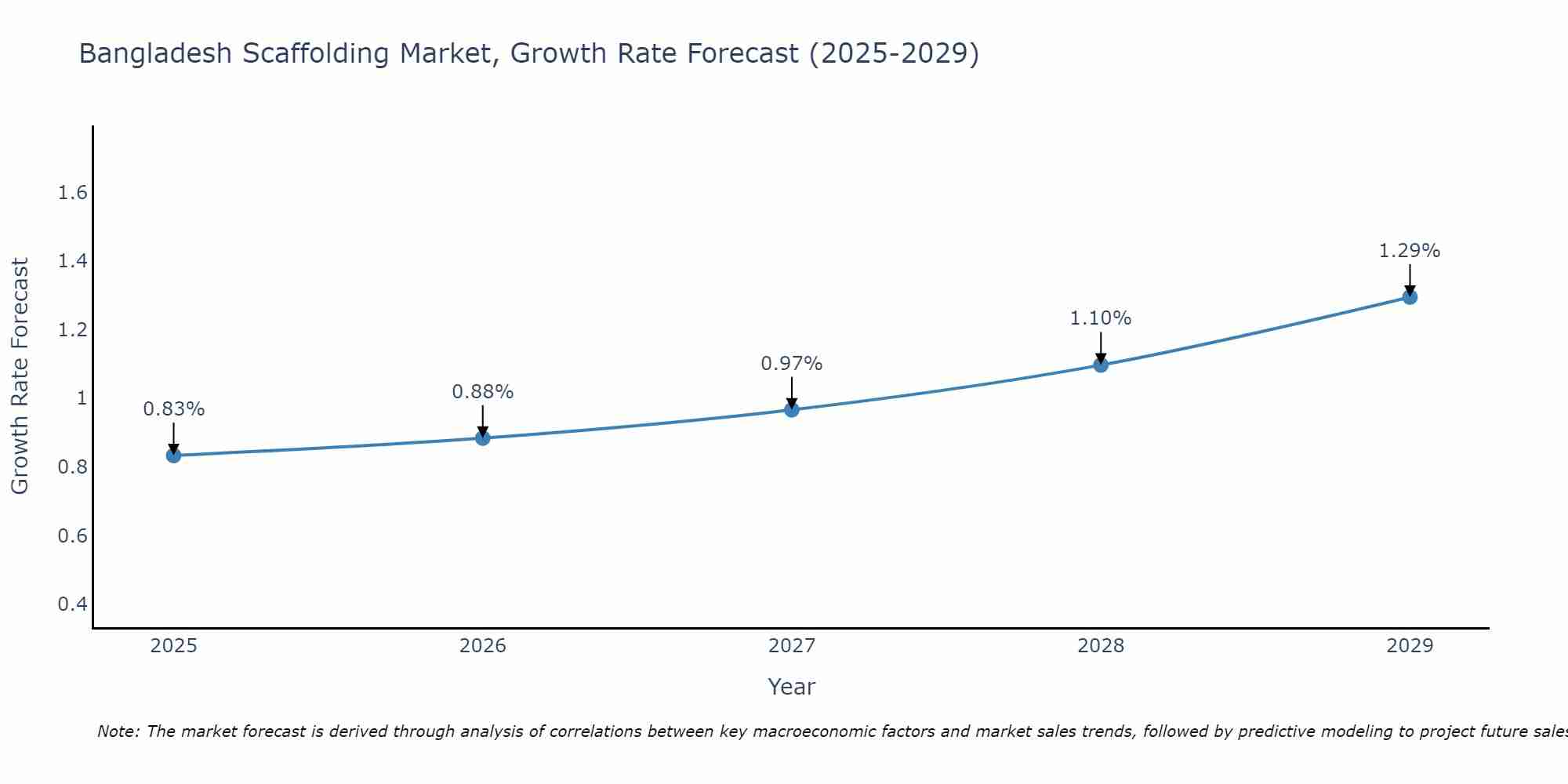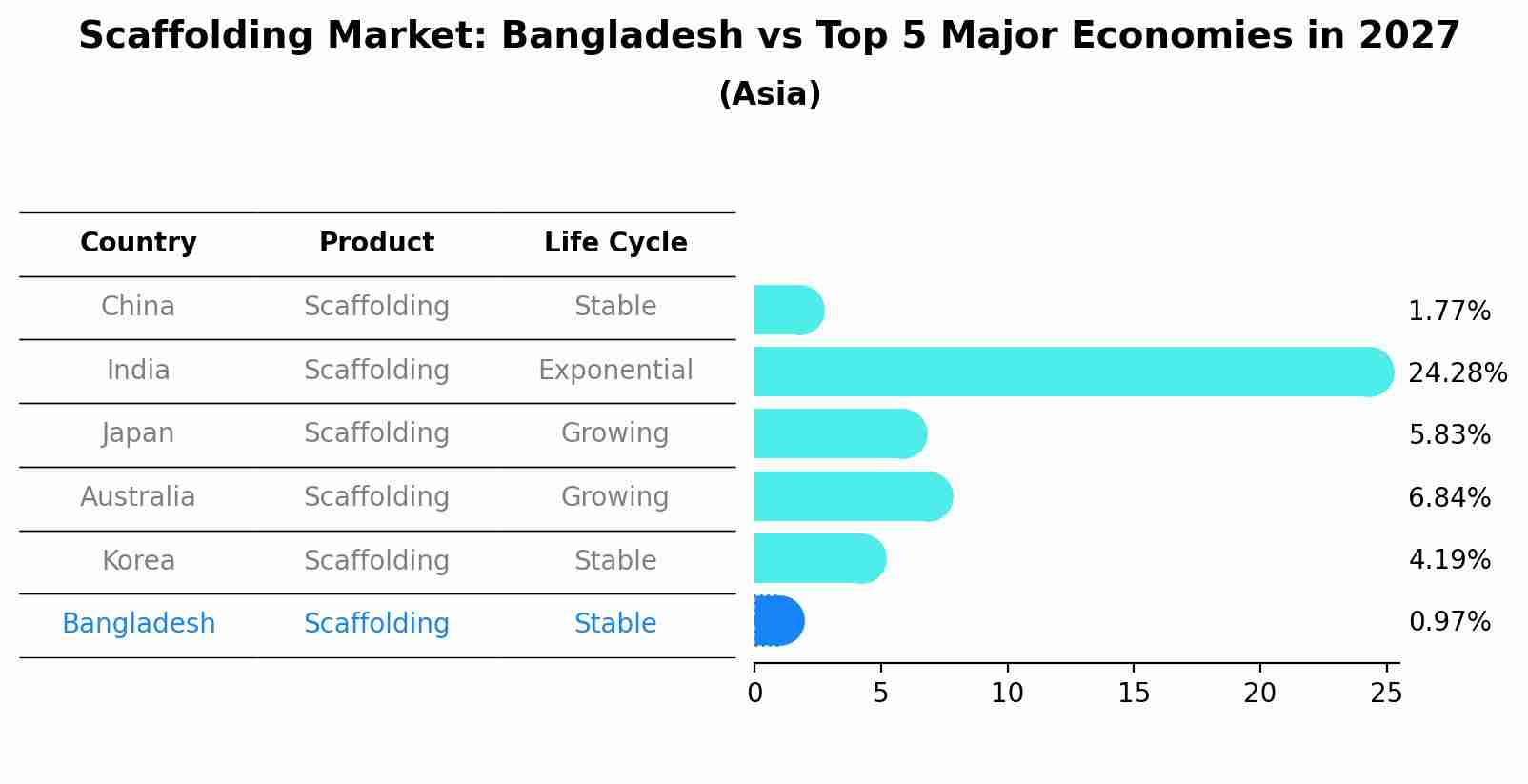Bangladesh Scaffolding Market (2025-2031) Outlook | Analysis, Value, Forecast, Share, Trends, Revenue, Size, Industry, Growth & Companies
| Product Code: ETC377792 | Publication Date: Aug 2022 | Updated Date: Jul 2025 | Product Type: Market Research Report | |
| Publisher: 6Wresearch | Author: Ravi Bhandari | No. of Pages: 75 | No. of Figures: 35 | No. of Tables: 20 |
Bangladesh Scaffolding Market Size Growth Rate
The Bangladesh Scaffolding Market is poised for steady growth rate improvements from 2025 to 2029. The growth rate starts at 0.83% in 2025 and reaches 1.29% by 2029.

Scaffolding Market: Bangladesh vs Top 5 Major Economies in 2027 (Asia)
In the Asia region, the Scaffolding market in Bangladesh is projected to expand at a stable growth rate of 0.97% by 2027. The largest economy is China, followed by India, Japan, Australia and South Korea.

Bangladesh Scaffolding Market Synopsis
The Bangladesh scaffolding market is experiencing steady growth due to the increasing construction activities in the country. The demand for scaffolding is driven by the booming real estate sector, infrastructure development projects, and industrial construction. The market is characterized by a variety of scaffolding products such as steel scaffolding, aluminum scaffolding, and wooden scaffolding, catering to different construction requirements. Key players in the Bangladesh scaffolding market include both local manufacturers and international companies offering innovative and high-quality products. Government initiatives to improve infrastructure and promote urban development are expected to further fuel the demand for scaffolding in the country, making it a lucrative market for both domestic and international players.
Bangladesh Scaffolding Market Trends
The Bangladesh scaffolding market is witnessing a growing demand due to increasing construction activities in the country. Key trends in the market include a shift towards safer and more efficient scaffolding systems, such as aluminum and modular scaffolding, to improve worker safety and productivity. Additionally, there is a rising preference for rental scaffolding services among construction companies to reduce upfront costs and logistical challenges. The market is also seeing a focus on sustainable and environmentally friendly scaffolding materials to align with global sustainability goals. With the government`s infrastructure development projects driving the construction sector, the Bangladesh scaffolding market is expected to continue its growth trajectory in the coming years.
Bangladesh Scaffolding Market Challenges
In the Bangladesh scaffolding market, several challenges are faced including a lack of standardized regulations and safety protocols, leading to potential safety hazards for workers. Additionally, the market is highly fragmented with many small and unorganized players, resulting in price competition and inconsistent quality of scaffolding products. Limited awareness of advanced scaffolding technologies and practices among construction companies is another challenge, hindering the adoption of more efficient and safe scaffolding systems. Moreover, the availability of skilled labor for proper installation and dismantling of scaffolding structures remains a concern. Overall, addressing these challenges through improved regulations, industry education, and promoting best practices is crucial for the sustainable growth of the scaffolding market in Bangladesh.
Bangladesh Scaffolding Market Investment Opportunities
The Bangladesh scaffolding market presents promising investment opportunities due to the country`s growing construction industry. With numerous infrastructure projects underway and a rising demand for commercial and residential developments, there is a high demand for scaffolding equipment and services. Investors can consider opportunities in supplying scaffolding materials such as steel pipes, couplers, and planks, as well as providing scaffolding rental services to construction companies. Additionally, there is potential for introducing innovative and environmentally sustainable scaffolding solutions to differentiate in the market. Investing in the Bangladesh scaffolding market can offer attractive returns and long-term growth potential as the construction industry continues to expand.
Jordan Agar Market Government Policies
The government of Bangladesh has implemented various policies to regulate the scaffolding market in the country. These policies include licensing requirements for scaffolding companies to ensure compliance with safety standards, environmental regulations, and worker protection laws. Additionally, the government has set guidelines for the use of scaffolding equipment to prevent accidents and ensure the structural integrity of buildings under construction or renovation. Furthermore, there are regulations in place to monitor the quality of scaffolding materials used in construction projects to maintain standards and prevent substandard products from entering the market. Overall, these government policies aim to promote safety, quality, and compliance within the Bangladesh scaffolding market to protect both workers and the public.
Bangladesh Scaffolding Market Future Outlook
The Bangladesh scaffolding market is poised for significant growth in the coming years due to the country`s burgeoning construction industry. Rapid urbanization, infrastructure development projects, and a growing demand for residential and commercial properties are driving the need for scaffolding systems. Additionally, government initiatives to improve public infrastructure, such as roads, bridges, and transportation networks, are expected to further boost the market. The emergence of new technologies in the scaffolding industry, such as lightweight and durable materials, advanced safety features, and digital monitoring systems, will also contribute to market expansion. Overall, the future outlook for the Bangladesh scaffolding market is positive, with opportunities for both local and international scaffolding companies to capitalize on the growing demand for construction services in the country.
Key Highlights of the Report:
- Bangladesh Scaffolding Market Outlook
- Market Size of Bangladesh Scaffolding Market, 2024
- Forecast of Bangladesh Scaffolding Market, 2031
- Historical Data and Forecast of Bangladesh Scaffolding Revenues & Volume for the Period 2021 - 2031
- Bangladesh Scaffolding Market Trend Evolution
- Bangladesh Scaffolding Market Drivers and Challenges
- Bangladesh Scaffolding Price Trends
- Bangladesh Scaffolding Porter's Five Forces
- Bangladesh Scaffolding Industry Life Cycle
- Historical Data and Forecast of Bangladesh Scaffolding Market Revenues & Volume By Type for the Period 2021 - 2031
- Historical Data and Forecast of Bangladesh Scaffolding Market Revenues & Volume By Supported Scaffolding for the Period 2021 - 2031
- Historical Data and Forecast of Bangladesh Scaffolding Market Revenues & Volume By Suspended Scaffolding for the Period 2021 - 2031
- Historical Data and Forecast of Bangladesh Scaffolding Market Revenues & Volume By Rolling Scaffolding for the Period 2021 - 2031
- Historical Data and Forecast of Bangladesh Scaffolding Market Revenues & Volume By Material for the Period 2021 - 2031
- Historical Data and Forecast of Bangladesh Scaffolding Market Revenues & Volume By Aluminum for the Period 2021 - 2031
- Historical Data and Forecast of Bangladesh Scaffolding Market Revenues & Volume By Wood for the Period 2021 - 2031
- Historical Data and Forecast of Bangladesh Scaffolding Market Revenues & Volume By Steel for the Period 2021 - 2031
- Historical Data and Forecast of Bangladesh Scaffolding Market Revenues & Volume By End User for the Period 2021 - 2031
- Historical Data and Forecast of Bangladesh Scaffolding Market Revenues & Volume By Residential for the Period 2021 - 2031
- Historical Data and Forecast of Bangladesh Scaffolding Market Revenues & Volume By Commercial for the Period 2021 - 2031
- Historical Data and Forecast of Bangladesh Scaffolding Market Revenues & Volume By Industrial for the Period 2021 - 2031
- Bangladesh Scaffolding Import Export Trade Statistics
- Market Opportunity Assessment By Type
- Market Opportunity Assessment By Material
- Market Opportunity Assessment By End User
- Bangladesh Scaffolding Top Companies Market Share
- Bangladesh Scaffolding Competitive Benchmarking By Technical and Operational Parameters
- Bangladesh Scaffolding Company Profiles
- Bangladesh Scaffolding Key Strategic Recommendations
Frequently Asked Questions About the Market Study (FAQs):
- Single User License$ 1,995
- Department License$ 2,400
- Site License$ 3,120
- Global License$ 3,795
Search
Thought Leadership and Analyst Meet
Our Clients
Related Reports
- Afghanistan Apparel Market (2026-2032) | Growth, Outlook, Industry, Segmentation, Forecast, Size, Companies, Trends, Value, Share, Analysis & Revenue
- Canada Oil and Gas Market (2026-2032) | Share, Segmentation, Value, Industry, Trends, Forecast, Analysis, Size & Revenue, Growth, Competitive Landscape, Outlook, Companies
- Germany Breakfast Food Market (2026-2032) | Industry, Share, Growth, Size, Companies, Value, Analysis, Revenue, Trends, Forecast & Outlook
- Australia Briquette Market (2025-2031) | Growth, Size, Revenue, Forecast, Analysis, Trends, Value, Share, Industry & Companies
- Vietnam System Integrator Market (2025-2031) | Size, Companies, Analysis, Industry, Value, Forecast, Growth, Trends, Revenue & Share
- ASEAN and Thailand Brain Health Supplements Market (2025-2031) | Strategy, Consumer Insights, Analysis, Investment Trends, Opportunities, Growth, Size, Share, Industry, Revenue, Segments, Value, Segmentation, Supply, Forecast, Restraints, Outlook, Competition, Drivers, Trends, Demand, Pricing Analysis, Competitive, Strategic Insights, Companies, Challenges
- ASEAN Bearings Market (2025-2031) | Strategy, Consumer Insights, Analysis, Investment Trends, Opportunities, Growth, Size, Share, Industry, Revenue, Segments, Value, Segmentation, Supply, Forecast, Restraints, Outlook, Competition, Drivers, Trends, Demand, Pricing Analysis, Competitive, Strategic Insights, Companies, Challenges
- Europe Flooring Market (2025-2031) | Outlook, Share, Industry, Trends, Forecast, Companies, Revenue, Size, Analysis, Growth & Value
- Saudi Arabia Manlift Market (2025-2031) | Outlook, Size, Growth, Trends, Companies, Industry, Revenue, Value, Share, Forecast & Analysis
- Uganda Excavator, Crane, and Wheel Loaders Market (2025-2031) | Strategy, Consumer Insights, Analysis, Investment Trends, Opportunities, Growth, Size, Share, Industry, Revenue, Segments, Value, Segmentation, Supply, Forecast, Restraints, Outlook, Competition, Drivers, Trends, Demand, Pricing Analysis, Competitive, Strategic Insights, Companies, Challenges
Industry Events and Analyst Meet
Whitepaper
- Middle East & Africa Commercial Security Market Click here to view more.
- Middle East & Africa Fire Safety Systems & Equipment Market Click here to view more.
- GCC Drone Market Click here to view more.
- Middle East Lighting Fixture Market Click here to view more.
- GCC Physical & Perimeter Security Market Click here to view more.
6WResearch In News
- Doha a strategic location for EV manufacturing hub: IPA Qatar
- Demand for luxury TVs surging in the GCC, says Samsung
- Empowering Growth: The Thriving Journey of Bangladesh’s Cable Industry
- Demand for luxury TVs surging in the GCC, says Samsung
- Video call with a traditional healer? Once unthinkable, it’s now common in South Africa
- Intelligent Buildings To Smooth GCC’s Path To Net Zero


















